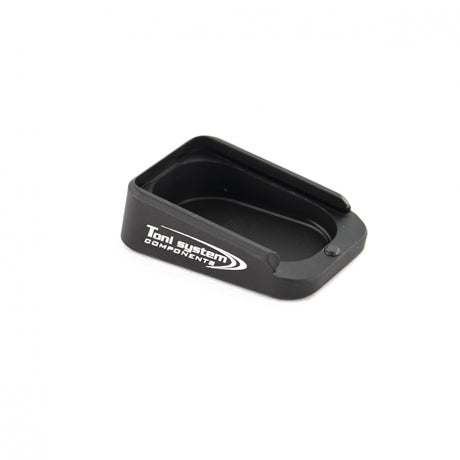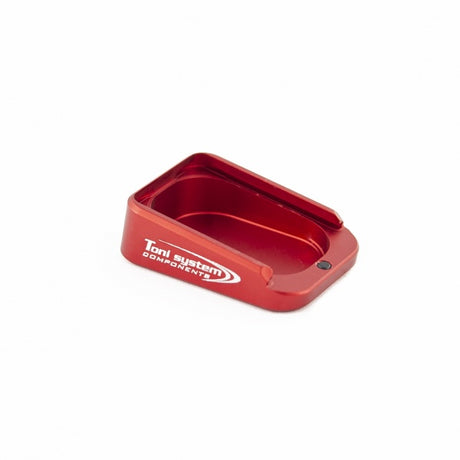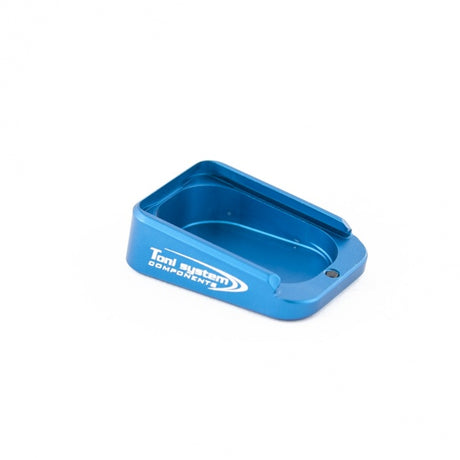Base pads
(55 products)
Base pads (a.k.a. magazine pads or extensions) replace the factory floorplate to add a grippy bumper for faster, surer reloads—and, on many models, extra capacity. They’re also essential when running a magwell, where pad height and shape help magazines seat positively.
Why upgrade your base pads?
-
Faster reloads & consistency: a wider, textured pad gives you a positive grab and helps mags lock in under stress.
-
Added capacity (model-dependent): extensions can provide added rounds for competition or range—check the product notes for exact gains.
-
Magwell compatibility: “magwell-compatible” pads add the height/geometry needed to clear the funnel and seat flush.
-
Durability: aluminum/brass pads shrug off drops better than thin OEM plates.
Choose the right type
-
+0 (bumper) pads: no capacity change; improve seating and protection. Ideal for duty/EDC or rule-limited divisions.
-
+extension pads: add capacity where allowed. Some models require a spring/follower kit for reliable feeding—see product description.
Compatibility—what to check
Always match pad to your pistol model, magazine brand/generation, and division rules. Key platform notes:
-
1911/2011: magwell setups usually need extended pads to seat against large funnels; verify Government/Commander vs. Officer mags and mainspring-housing/magwell style.
-
CZ metal-frame (75/SP-01/Shadow, TS/TS 2): factory mags vary by length and base. With magwells, use pads labeled magwell-compatible; older frames with lanyard loops may need a flush plug.
-
Glock Gen3/4/5: pads are gen- and frame-specific. Many magwells require low-profile or specific “magwell” pads for reliable seating.
-
SIG P320/P365 & classic P-series: P320 uses module-specific mags (Carry/Full/X-Series). P365 pads must match mag length (10/12/15). Classic P226/P229 pads differ by mag body and grip panel style—check notes.
-
Beretta 92/92X/M9A3–A4 & 92X Performance: verify OEM vs. Mec-Gar mags; competition builds with magwells need extended, funnel-friendly pads.
-
Walther PDP/Q5/Q4 & HK VP9/P30/USP: match frame size (Full-Size/Compact) and pad style; some magwells/backstraps require specific pad geometry.
Materials
Aluminum
Pros: light, tough, widely available, many anodized finishes. Cons: shows cosmetic wear with hard use.
Brass
Pros: adds mass for stability and positive seating; very durable. Cons: heavier—less ideal for all-day carry.
Polymer
Pros: light, affordable, good for EDC. Cons: less impact-resistant than metal.
How to choose—quick checklist
-
Use case: EDC/range (often +0) vs. competition (capacity, division limits, magazine length gauges).
-
Magwell: if you run one, pick magwell-compatible pads and confirm they seat on a closed slide.
-
Magazine brand/gen: OEM vs. aftermarket (e.g., Mec-Gar) and generation matters for fit.
-
Springs/followers: required for some larger extensions—follow the product guidance.
-
Overall length limits: check your sport’s box/gauge rules before choosing extension size.
Install basics
- Unload and remove the magazine; wear eye protection—springs are under tension.
- Slide off the OEM floorplate, control the spring, and transfer parts per the pad’s instructions.
- For extensions, install any supplied spring/follower and assemble in order.
- Function-check: lock the slide back, insert a loaded mag to confirm positive seating (especially with a magwell), then verify drop-free.
Troubleshooting tips
-
Won’t seat with magwell: pad not magwell-compatible or too short—choose a taller pad designed for your funnel/frame.
-
Last rounds nose-down: upgrade to the spring/follower kit recommended for that extension size.
-
Doesn’t drop free: check burrs/debris, over-tight screws, or frame contact; verify mag body brand/gen.







![Springfield [HS] XDM [SF19] alu base pad [.45 ACP]](http://ubitzu.eu/cdn/shop/files/Springfield_HS_XDM_SF19_alu_base_pad_.45_ACP.jpg?v=1761413910&width=460)
![Springfield [HS] XDM [SF19] alu base pad [.45 ACP]](http://ubitzu.eu/cdn/shop/files/Springfield_HS_XDM_SF19_alu_base_pad_.45_ACP_red.jpg?v=1761413910&width=460)
![Springfield [HS] XDM [SF19] alu base pad [.45 ACP]](http://ubitzu.eu/cdn/shop/files/Springfield_HS_XDM_SF19_alu_base_pad_.45_ACP_blue.jpg?v=1761413910&width=460)
![Springfield [HS] XDM [SF19] alu base pad [9x19]](http://ubitzu.eu/cdn/shop/files/Springfield_HS_XDM_SF19_alu_base_pad_9x19_a3c3a193-ffb8-4e1d-bc8b-0415ff7424e8.jpg?v=1761413767&width=460)
![Springfield [HS] XDM [SF19] alu base pad [9x19]](http://ubitzu.eu/cdn/shop/files/Springfield_HS_XDM_SF19_alu_base_pad_9x19_red.jpg?v=1761413767&width=460)
![Springfield [HS] XDM [SF19] alu base pad [9x19]](http://ubitzu.eu/cdn/shop/files/Springfield_HS_XDM_SF19_alu_base_pad_9x19_blue.jpg?v=1761413767&width=460)













![Glock [G17, G34, G45] alu base pad | +9 rounds](http://ubitzu.eu/cdn/shop/files/Glock_G17_G34_G45_gen._3_gen.4_gen.5_alu_base_pad_9_rounds.jpg?v=1761412213&width=460)
![Glock [G17, G34, G45] alu base pad | +9 rounds](http://ubitzu.eu/cdn/shop/files/Glock_G17_G34_G45_gen._3_gen.4_gen.5_alu_base_pad_9_rounds_red.jpg?v=1761412213&width=460)
![Glock [G17, G34, G45] alu base pad | +9 rounds](http://ubitzu.eu/cdn/shop/files/Glock_G17_G34_G45_gen._3_gen.4_gen.5_alu_base_pad_9_rounds_blue.jpg?v=1761412213&width=460)



![Glock [G17, G34, G45] alu base pad | +5 rounds](http://ubitzu.eu/cdn/shop/files/Glock_G17_G34_G45_gen._3_gen.4_gen.5_alu_base_pad_5_rounds.jpg?v=1761411923&width=460)
![Glock [G17, G34, G45] alu base pad | +5 rounds](http://ubitzu.eu/cdn/shop/files/Glock_G17_G34_G45_gen._3_gen.4_gen.5_alu_base_pad_5_rounds_red.jpg?v=1761411923&width=460)
![Glock [G17, G34, G45] alu base pad | +5 rounds](http://ubitzu.eu/cdn/shop/files/Glock_G17_G34_G45_gen._3_gen.4_gen.5_alu_base_pad_5_rounds_blue.jpg?v=1761411923&width=460)
![Glock [G17, G19, G34, G45] alu base pad | +2 rounds](http://ubitzu.eu/cdn/shop/files/Glock_G17_G19_G34_G45_gen._3_4_5_alu_base_pad_2_rounds.jpg?v=1761411748&width=460)
![Glock [G17, G19, G34, G45] alu base pad | +2 rounds](http://ubitzu.eu/cdn/shop/files/Glock_G17_G19_G34_G45_gen._3_4_5_alu_base_pad_2_rounds_red.jpg?v=1761411748&width=460)
![Glock [G17, G19, G34, G45] alu base pad | +2 rounds](http://ubitzu.eu/cdn/shop/files/Glock_G17_G19_G34_G45_gen._3_4_5_alu_base_pad_2_rounds_blue.jpg?v=1761411748&width=460)
![Glock [G17, G19, G34, G45] alu base pad | +1 round](http://ubitzu.eu/cdn/shop/files/Glock_G17_G19_G45_gen._3_4_5_alu_base_pad_1_round.jpg?v=1761411651&width=460)
![Glock [G17, G19, G34, G45] alu base pad | +1 round](http://ubitzu.eu/cdn/shop/files/Glock_G17_G19_G45_gen._3_4_5_alu_base_pad_1_round_red.jpg?v=1761411651&width=460)
![Glock [G17, G19, G34, G45] alu base pad | +1 round](http://ubitzu.eu/cdn/shop/files/Glock_G17_G19_G45_gen._3_4_5_alu_base_pad_1_round_blue.jpg?v=1761411651&width=460)
![CZ TS 2 [& CZ TS 1] brass base pad | +1 round](http://ubitzu.eu/cdn/shop/files/CZ_TS_2_CZ_TS_1_brass_base_pad_1_round.jpg?v=1761386796&width=460)



![CZ TS 2 [& CZ TS 1] alu base pad | +4 rounds](http://ubitzu.eu/cdn/shop/files/CZ_TS_2_CZ_TS_1_alu_base_pad_4_round.jpg?v=1761386494&width=460)
![CZ TS 2 [& CZ TS 1] alu base pad | +4 rounds](http://ubitzu.eu/cdn/shop/files/CZ_TS_2_CZ_TS_1_alu_base_pad_4_round_red.jpg?v=1761386494&width=460)
![CZ TS 2 [& CZ TS 1] alu base pad | +4 rounds](http://ubitzu.eu/cdn/shop/files/CZ_TS_2_CZ_TS_1_alu_base_pad_4_round_blue.jpg?v=1761386494&width=460)